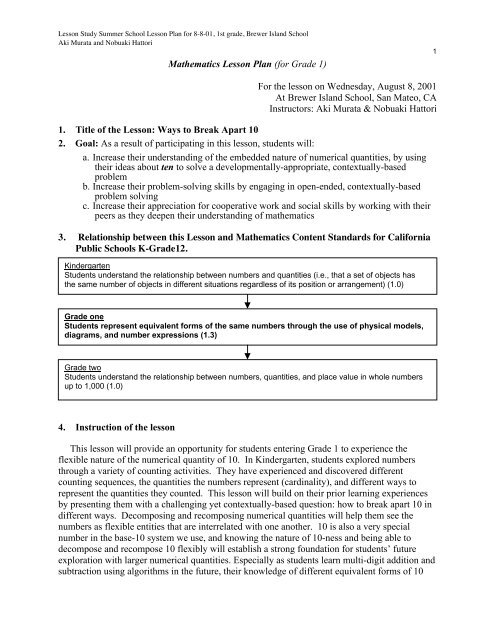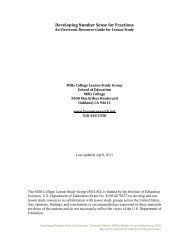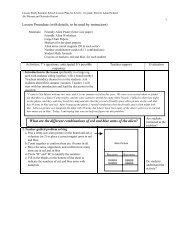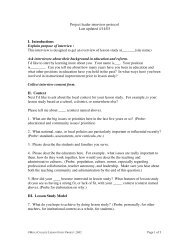Mathematics Lesson Plan (for Grade 1) - Lesson Study Group at ...
Mathematics Lesson Plan (for Grade 1) - Lesson Study Group at ...
Mathematics Lesson Plan (for Grade 1) - Lesson Study Group at ...
- No tags were found...
Create successful ePaper yourself
Turn your PDF publications into a flip-book with our unique Google optimized e-Paper software.
<strong>Lesson</strong> <strong>Study</strong> Summer School <strong>Lesson</strong> <strong>Plan</strong> <strong>for</strong> 8-8-01, 1st grade, Brewer Island SchoolAki Mur<strong>at</strong>a and Nobuaki H<strong>at</strong>tori<strong>M<strong>at</strong>hem<strong>at</strong>ics</strong> <strong>Lesson</strong> <strong>Plan</strong> (<strong>for</strong> <strong>Grade</strong> 1)1For the lesson on Wednesday, August 8, 2001At Brewer Island School, San M<strong>at</strong>eo, CAInstructors: Aki Mur<strong>at</strong>a & Nobuaki H<strong>at</strong>tori1. Title of the <strong>Lesson</strong>: Ways to Break Apart 102. Goal: As a result of particip<strong>at</strong>ing in this lesson, students will:a. Increase their understanding of the embedded n<strong>at</strong>ure of numerical quantities, by usingtheir ideas about ten to solve a developmentally-appropri<strong>at</strong>e, contextually-basedproblemb. Increase their problem-solving skills by engaging in open-ended, contextually-basedproblem solvingc. Increase their appreci<strong>at</strong>ion <strong>for</strong> cooper<strong>at</strong>ive work and social skills by working with theirpeers as they deepen their understanding of m<strong>at</strong>hem<strong>at</strong>ics3. Rel<strong>at</strong>ionship between this <strong>Lesson</strong> and <strong>M<strong>at</strong>hem<strong>at</strong>ics</strong> Content Standards <strong>for</strong> Cali<strong>for</strong>niaPublic Schools K-<strong>Grade</strong>12.KindergartenStudents understand the rel<strong>at</strong>ionship between numbers and quantities (i.e., th<strong>at</strong> a set of objects hasthe same number of objects in different situ<strong>at</strong>ions regardless of its position or arrangement) (1.0)<strong>Grade</strong> oneStudents represent equivalent <strong>for</strong>ms of the same numbers through the use of physical models,diagrams, and number expressions (1.3)<strong>Grade</strong> twoStudents understand the rel<strong>at</strong>ionship between numbers, quantities, and place value in whole numbersup to 1,000 (1.0)4. Instruction of the lessonThis lesson will provide an opportunity <strong>for</strong> students entering <strong>Grade</strong> 1 to experience theflexible n<strong>at</strong>ure of the numerical quantity of 10. In Kindergarten, students explored numbersthrough a variety of counting activities. They have experienced and discovered differentcounting sequences, the quantities the numbers represent (cardinality), and different ways torepresent the quantities they counted. This lesson will build on their prior learning experiencesby presenting them with a challenging yet contextually-based question: how to break apart 10 indifferent ways. Decomposing and recomposing numerical quantities will help them see thenumbers as flexible entities th<strong>at</strong> are interrel<strong>at</strong>ed with one another. 10 is also a very specialnumber in the base-10 system we use, and knowing the n<strong>at</strong>ure of 10-ness and being able todecompose and recompose 10 flexibly will establish a strong found<strong>at</strong>ion <strong>for</strong> students’ futureexplor<strong>at</strong>ion with larger numerical quantities. Especially as students learn multi-digit addition andsubtraction using algorithms in the future, their knowledge of different equivalent <strong>for</strong>ms of 10
<strong>Lesson</strong> <strong>Study</strong> Summer School <strong>Lesson</strong> <strong>Plan</strong> <strong>for</strong> 8-8-01, 1st grade, Brewer Island SchoolAki Mur<strong>at</strong>a and Nobuaki H<strong>at</strong>toriwill help them understand the place-value system and the process and the mechanics of thealgorithms better.In this lesson, two teachers play important roles in supporting one another and cre<strong>at</strong>ing acooper<strong>at</strong>ive and safe problem-solving <strong>at</strong>mosphere <strong>for</strong> students in the classroom. They willmodel the m<strong>at</strong>hem<strong>at</strong>ics discourse <strong>for</strong> students and supplement the discussion whenever necessaryas noted in the lesson plan.5. <strong>Lesson</strong> Procedure2Activities; Teachers’ questions; Anticip<strong>at</strong>ed studentresponses1. Introduction to the lesson: Introduction of teacherswill lead to the core problem of the lesson (findingdifferent combin<strong>at</strong>ions of red and blue arms of the alienwith 10 arms).Teacher supportWh<strong>at</strong> are the different combin<strong>at</strong>ions of red and blue arms of the alien?2. Teacher-guided problem solvingUsing an alien picture and cutout magnet arms on theboard, teacher 1 and a student volunteer (or 2) will showthe activity to the whole class.a. Place 10 magnet arms in different red-bluecombin<strong>at</strong>ionsb. Identify the number of arms using the magnetsc. Represent the combin<strong>at</strong>ion with numerals3. Individual Problem SolvingWith student worksheet with a smaller alien picture (1/2page size), students work as a pair or small groups tofind different combin<strong>at</strong>ion of the alien arms.Evalu<strong>at</strong>ionAre studentsinterested in theproblem?Do studentsunderstand theactivity?Are studentsworking as agroup?Anticip<strong>at</strong>ed student responses1. Just color with visually different p<strong>at</strong>terns, and thencount the numbers of arms (may repe<strong>at</strong> the samenumber combin<strong>at</strong>ions).2. Color with the increasing p<strong>at</strong>tern with one color,color the remaining arms with another, and thencount the numbers of arms.3. Identify the number combin<strong>at</strong>ions first numerically,and then color the arms (fast students).If some groups find manycombin<strong>at</strong>ions quickly, they mayspread their work on the floor ortable to examine the rel<strong>at</strong>ionshipsand seek a p<strong>at</strong>tern.Are studentsengaged in theactivity?4. Sharing of ideasa. Using a prepared chart on the board, teacher 2 leadsstudents to share the combin<strong>at</strong>ions they found withalien pictures.b. While identifying the combin<strong>at</strong>ions, teacher 2 alsoputs up number combin<strong>at</strong>ion cards (prepared) to makethe p<strong>at</strong>tern visible.5. Synthesizing the ideasa. Teachers help students identify any p<strong>at</strong>tern throughTeacher 1 walks around andchecks students’ work. Whencertain combin<strong>at</strong>ion is missing onthe chart, teacher 1 tries to find itin a student’s work.Do studentsnotice a p<strong>at</strong>tern?
<strong>Lesson</strong> <strong>Study</strong> Summer School <strong>Lesson</strong> <strong>Plan</strong> <strong>for</strong> 8-8-01, 1st grade, Brewer Island SchoolAki Mur<strong>at</strong>a and Nobuaki H<strong>at</strong>toridiscussion.Anticip<strong>at</strong>ed student responses1. Numbers are reverse <strong>for</strong> some combin<strong>at</strong>ions2. Each column has numbers 1 through 9 (10).3. When number increases in one column, itdecreases in the other.4. When number increases in one column byone, it decreases in the other by one.3b. Discuss why there is a p<strong>at</strong>tern.c. Identify the combin<strong>at</strong>ions to break apart 10 and thep<strong>at</strong>terns among them.6. Summing UpWith the list on the board with students’ commentsabout rel<strong>at</strong>ional p<strong>at</strong>terns they noticed, students write intheir journals (or on pieces of paper) wh<strong>at</strong> they havelearned today, using any method they may be able to useto record (words, numbers, pictures, etc.)Do students usedifferent waysto express andrecord theirlearning?6. Evalu<strong>at</strong>ions:1) Does a student find more than one way to break apart 10?2) Does a student notice a p<strong>at</strong>tern in number combin<strong>at</strong>ions to break apart 10?3) Does a student use his/her prior understanding of numerical quantities to approach the problem ofbreaking apart 10?4) Does a student work cooper<strong>at</strong>ively in a group situ<strong>at</strong>ion?






